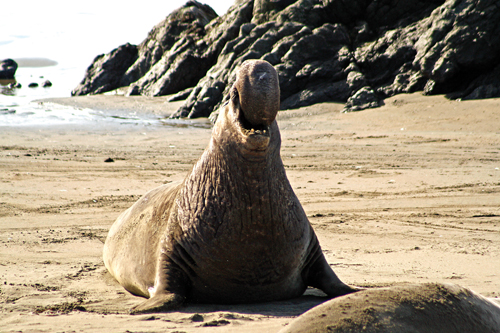
An Alpha male elephant seal dominates his space at the rookery near the Piedras Blancas Lighthouse.
View thousands of elephant seals along Highway 1
You and a friend are driving down the coast highway in December of 1993 on your way to visit the coastal towns of Cambria, Cayucos and Morro Bay. The weather is balmy, you see the sun shining off the face of the large white rock just offshore of Piedras Blancas Lighthouse, your friend is snoozing in the passenger seat and you wonder why she doesn’t want to look at this magnificent view. You shift your view just a smidge and suddenly slam your foot on the brakes. “What’s happening?” Your friend awakes with a start. “Look!” You both stare ahead towards the beach where hundreds of brownish lumps are lying on the sand. What you have discovered is the newest mainland elephant seal rookery on the West Coast.
That’s how it was for folks traveling the coast during the early 1990s as they came upon the Northern Elephant Seal Rookery at Piedras Blancas, an amazing discovery of a pinniped phenomenon that even scientists could not have predicted.
Elephant seals started landing on this beach as early as 1990. Prior to that, a group of seals had started colonizing a beach at Gordo, but they were not easily accessible or noticeable. The only other mainland colonies of elephant seals at the time were at Ano Nuevo and Point Reyes.
From near-extinction to colonies
These huge sea mammals were making a remarkable recovery from near extinction having been hunted for their blubber and oil during the 18th and 19th centuries. At the end of that period, only 50 animals were left. From that small group came all the northern elephant seals on the Pacific Coast. Now there are breeding colonies from Baja to British Columbia and at four California mainland sites.
Today, thanks to the development of the Friends of the Elephant Seals volunteer organization, no one is allowed to venture down onto the beaches near the seals. A large parking area accommodates vehicles, and a long stretch of boardwalk has been constructed just above the main rookery beach. Docents are on hand every day from 10 a.m.to 4 p.m. to greet visitors and tell them about the seals – it is one of the best wild animal viewing sites in the country and it is free!
The population at Piedras Blancas is around 20,000 elephant seals, but all of the seals are not present all of the time; numbers depend on the time of year and what is occurring in the life of an elephant seal.
Adult males, females & pups
Adult male seals begin to come ashore here in late November, early December. These two-ton animals enter into battles for the prime spots on the beach. Alpha males, the winners of these contests, take charge of the space with Beta males staying nearby; only Alpha males will breed.
Females, most of whom are pregnant, come ashore in mid-December and form into harems around an Alpha male. They are not necessarily choosing him, but are selecting the best places on the beach to give birth.
Pups are born throughout the month of January; by mid-January the beach is alive with small, black, wiggling pups and loud chirping sounds fill the air as they make known their desire to nurse. Nursing continues for four weeks during as pups gain weight from the rich, fat milk and eventually quadruple in size. Pups are the only seals being nourished since both males and females fast throughout the three-plus months they spend in the rookery.
From December through February, visitors will see the most activity in the rookery. For the most part, the seals lay motionless sleeping and flipping sand onto their backs. Every now and then fights will break out between females who challenge each other for the spaces they hold on the beach.
In mid-February females wean their pups and are ready to breed again. Alpha males pursue them and often roll over an unsuspecting pup in their eagerness to engage the females. Once bred, females leave the beach and go out to sea to feed. Males remain until the last female has gone.
Spring and summer viewing
In March, the pups, now called weaners, gather together and begin to venture down to the water and paddle around in the rocky tidepools. As they waddle across the sands they are strengthening their muscles preparing them for the time when they will go out to sea.
In April and May females and juveniles return to the beach, go through their yearly molt and shed both hair and the top layer of skin – the seals fast for the duration of the molt. Visitors will see upwards of 4,000 seals at the site during this time.
June and July have the females and juveniles leaving and sub-adult males coming in to molt. These young males will practice-fight each other in anticipation of challenging larger males during next breeding season. In August and September, large males return to molt; there are fewer seals on the beach, but the biggest seals are all present.
October and November is time for the fall haul out of yearlings and juveniles followed up by another breeding season at the Piedras Blancas Elephant Seal Rookery.
A new scientific project carried out in the sea just north of the rookery is the placement of a special buoy that records the presence and number of of great white sharks that are known to attack elephant seals.
Learn more about the seals at elephantseal.org, the website of Friends of the Elephant Seal, and check out the e-seal cam to watch live action in the rookery. The Visitor Center and Store is located at Cavalier Plaza in San Simeon.
— Ruth Ann Angus











